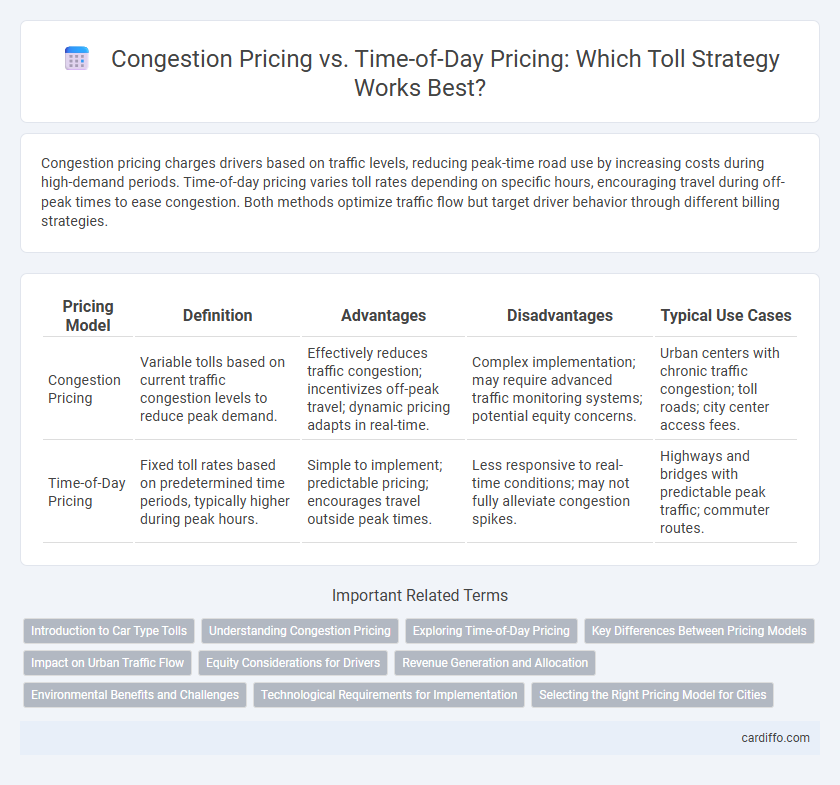Congestion pricing charges drivers based on traffic levels, reducing peak-time road use by increasing costs during high-demand periods. Time-of-day pricing varies toll rates depending on specific hours, encouraging travel during off-peak times to ease congestion. Both methods optimize traffic flow but target driver behavior through different billing strategies.
Table of Comparison
| Pricing Model | Definition | Advantages | Disadvantages | Typical Use Cases |
|---|---|---|---|---|
| Congestion Pricing | Variable tolls based on current traffic congestion levels to reduce peak demand. | Effectively reduces traffic congestion; incentivizes off-peak travel; dynamic pricing adapts in real-time. | Complex implementation; may require advanced traffic monitoring systems; potential equity concerns. | Urban centers with chronic traffic congestion; toll roads; city center access fees. |
| Time-of-Day Pricing | Fixed toll rates based on predetermined time periods, typically higher during peak hours. | Simple to implement; predictable pricing; encourages travel outside peak times. | Less responsive to real-time conditions; may not fully alleviate congestion spikes. | Highways and bridges with predictable peak traffic; commuter routes. |
Introduction to Car Type Tolls
Congestion pricing and time-of-day pricing are strategies designed to manage traffic flow by varying tolls based on demand, with particular implications for car type tolls. Car type tolls differentiate charges according to vehicle classification, considering factors such as size, weight, and emissions, which aligns with congestion pricing's goal of reducing road usage during peak hours. Time-of-day pricing further refines this approach by imposing variable tolls aligned with traffic intensity periods, incentivizing drivers of different car types to alter travel times and reduce congestion.
Understanding Congestion Pricing
Congestion pricing charges drivers higher tolls during peak traffic hours to reduce road congestion and improve traffic flow efficiency in urban areas. This dynamic pricing strategy allocates road space more effectively by discouraging non-essential trips during high-demand periods, leading to decreased travel times and lower emissions. By targeting real-time traffic conditions, congestion pricing optimizes infrastructure use and supports sustainable transportation management.
Exploring Time-of-Day Pricing
Time-of-Day Pricing adjusts toll rates based on specific periods, encouraging drivers to travel during off-peak hours and reducing congestion during peak times. This dynamic pricing strategy leverages real-time traffic data to optimize road usage and decrease overall travel delays. Studies show that implementing time-of-day tolls can lead to a 15-30% reduction in traffic congestion in urban areas.
Key Differences Between Pricing Models
Congestion pricing directly targets traffic volume by charging higher tolls during peak congestion periods, effectively managing demand and reducing gridlock. Time-of-day pricing varies toll rates based on predefined time intervals, distributing traffic more evenly over the day without necessarily responding to real-time congestion levels. Congestion pricing's dynamic rates are typically more flexible and responsive, whereas time-of-day pricing relies on static schedules, impacting driver behavior and traffic flow differently.
Impact on Urban Traffic Flow
Congestion pricing directly targets peak-hour traffic by imposing fees during high-demand periods, effectively reducing vehicle volume and encouraging alternative transportation modes in urban centers. Time-of-day pricing incentivizes drivers to travel during off-peak hours, smoothing traffic distribution and decreasing bottlenecks without completely deterring road usage. Both pricing models contribute to improved urban traffic flow but vary in their ability to shift travel behavior and reduce congestion intensity.
Equity Considerations for Drivers
Congestion pricing targets high-traffic areas during peak hours, potentially burdening low-income drivers with higher costs, while time-of-day pricing offers more flexibility by varying tolls based on travel times, which may better accommodate budget constraints. Equity considerations highlight the importance of income-based discounts or exemptions to prevent disproportionate impacts on disadvantaged communities. Implementing supportive measures such as improved public transit options ensures fair accessibility and reduces economic disparities among drivers.
Revenue Generation and Allocation
Congestion pricing generates higher and more consistent revenue by charging drivers based on real-time traffic conditions, effectively managing demand during peak hours. Time-of-day pricing allocates tolls according to predefined periods, often resulting in predictable but potentially lower revenue streams. Revenue from congestion pricing is frequently reinvested into public transit and infrastructure improvements, while time-of-day pricing funds may support maintenance and operational costs.
Environmental Benefits and Challenges
Congestion pricing reduces vehicle emissions by charging tolls based on traffic density, encouraging drivers to shift travel times or use alternative transportation, which lowers air pollution and greenhouse gas emissions in urban areas. Time-of-day pricing targets peak hours by setting toll rates according to specific travel periods, effectively smoothing traffic flow but may have limited impact on overall emissions if off-peak trips increase. Both pricing strategies face challenges in public acceptance, technological implementation, and ensuring equitable access while striving to promote sustainable transportation and improve air quality.
Technological Requirements for Implementation
Congestion pricing requires advanced traffic monitoring systems, dynamic tolling infrastructure, and real-time data analytics to adjust prices based on current traffic conditions. Time-of-day pricing relies on less complex technology, primarily scheduling software and static tolling equipment, as fees vary predictably by predefined time periods. Implementing congestion pricing demands integration with GPS, automated number plate recognition (ANPR), and mobile payment platforms to facilitate seamless, precise toll collection and enforcement.
Selecting the Right Pricing Model for Cities
Selecting the right pricing model for city tolls depends on traffic patterns, urban infrastructure, and policy goals. Congestion pricing targets real-time traffic density by charging higher tolls during peak congestion periods, effectively reducing demand and emissions in high-traffic zones. Time-of-day pricing offers predictable, lower costs during off-peak hours, incentivizing drivers to adjust travel times and easing overall roadway stress without the complexity of dynamic rate adjustments.
Congestion Pricing vs Time-of-Day Pricing Infographic

 cardiffo.com
cardiffo.com